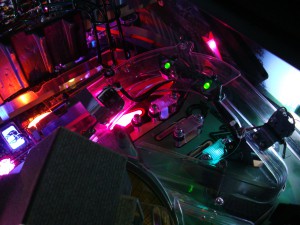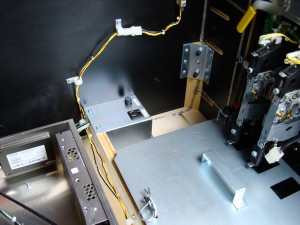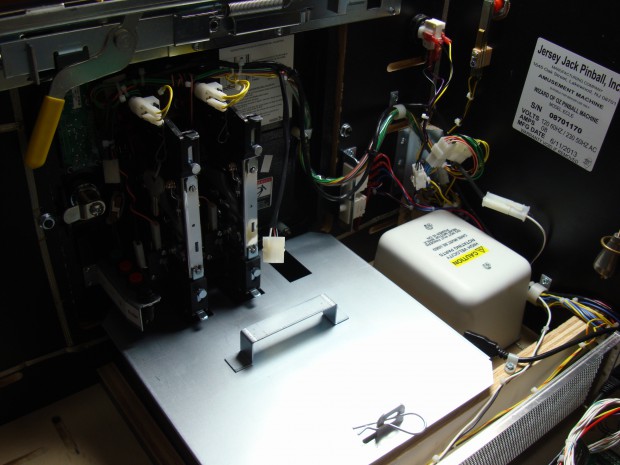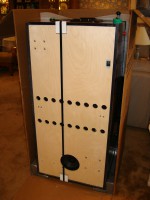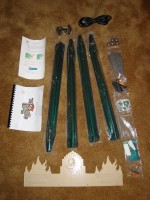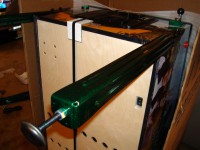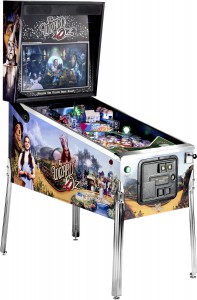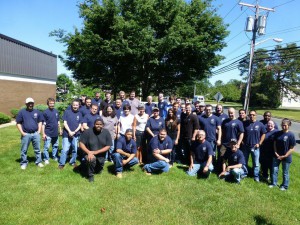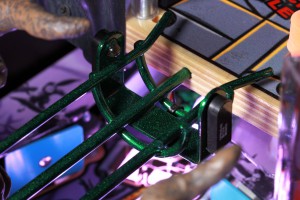|
Sunday August 4, 2013
Proper alignment equals optimal illumination.
JJP’s The Wizard of Oz pinball uses an entirely new type of general illumination (GI) system. Specifically, there are 23 surface-mount LEDs positioned below the playfield, each installed on a small circuit board attached to a metal mounting bracket. Since LEDs are normally highly directional (think laser beams), JJP has come up with a system where the LEDs shine through the playfield via clear plastic tubes with a frosted exterior, which are intended to carry the light up to the playfield surface for dispersion in method more similar to traditional non-directional incandescent bulbs.
At least, that’s the theory. One of the current discussion points for WOZ is that the general illumination is a little on the dim side – at least for those who like to play in a darkened room (like yours truly). This is enough of an issue that some WOZ owners are already showing off their newly modded games with added spotlights. Still, it’s been explained by Jersey Jack personnel that the game’s GI is currently running at only 36.5% power, meaning there’s a lot of brightness yet to be had, and an eagerly awaited software release is supposed to unlock some of this potential brightness. However, if you’re a WOZ owner looking forward to a brighter GI, then before this new software comes out you might want to first check something on your machine – because there could be a very good reason why your GI is not quite up to snuff, and it’s not something that a software upgrade will fix. The other day I was looking at the GI elements on my game, and I noticed that one obvious one was not showing any light – just the faintest of glows, as you can see in the first photo (it’s the one directly to the left of the “O” lane in “OZ”). Apparently, the most likely cause of this is that the LED circuit board has become “rotated” (since there’s only one mounting screw for each), resulting in the LED no longer shining directly through the plastic tube like it should. A simple loosening of the screw and correction of its position should fix the issue. Tonight, I lifted my playfield to make this adjustment... and was not prepared for what I found. Posted by Daniel Tonks on 8/04 at 7:38 AM
Wednesday July 24, 2013
The components that make Jersey Jack Pinball’s The Wizard of Oz a game designed like no other!
If you’ve been even casually following the development of JJP’s The Wizard of Oz pinball machine over the past two-and-a-half years (and by finding this blog, chances are high that you have been!), then it’s also quite likely that you’ve had the opportunity to see numerous photographs of the playfield and cabinet exterior. Ho hum, right?
Now don’t get me wrong – sure, I’m going to have plenty of high-resolution playfield photographs right here on Pinplay, but just not yet. For today, I thought it’d be more interesting to offer everyone a view of the game that’s a little less common: specifically, everything hidden inside that gorgeous clearcoated cabinet! True, there have been interior photographs taken of WOZ before, but most have been of prototype machines with non-final hardware, and quite a few changes have happened since those early days. So, let’s get started, and remember that you can click on each photo to blow it up – and then once again for extra-high-resolution!
Cabinet FrontJumping right in (as it were), in this first photograph we’re looking inside the front-right corner of the cabinet. The first thing techies will probably spot is the open electronics cage in the bottom left of the photograph, but kindly divert your eyes because we’ll be getting to that soon enough. Instead, why not behold the glory of the service outlet! Okay, well... there’s always the good ol’ coin box below two stock 25-cent mechanisms (incidentally, although quarters are appropriate for US machines, for operators here in Canada these should’ve been loonie and toonie mechanisms).If those items haven’t got the blood pumping yet, then for something that truly epitomizes the general build quality and sturdiness of JJP’s first pinball, take a look at those beefy metal corner brackets that the leg bolts attach to – an excellent idea considering that WOZ weighs north of 300 pounds! Also, note how the bottom of the cabinet is made from plywood instead of MDF, how the joints are constructed using pocket screws, and how the black paint is even down to the bottom of the panel without overspray. This is one good-looking and well-built game!
We’re now looking at the inside left side of the cabinet. In the top left corner of this photo is the yellow lockdown bar release handle, which unlatches two metal catches on the actual bar. Just to the right of the coin mechs, hidden inside that little plastic box plastered in warning notices, is the shaker motor. Above the shaker are the high voltage cut-off switches, along with various cables for the coin door electronics. You’ll note a second serial number sticker here on the inside of the cabinet, which duplicates the one on the back. Posted by Daniel Tonks on 7/24 at 8:14 AM
Friday July 19, 2013
It’s a tough job, but somebody’s gotta do it!
As many of you on the east coast are no doubt aware, we’ve been struck by a rather nasty heat wave – one that has made the main floor of my house less than comfortable to work in. But on Wednesday, I decided enough was enough – I simply had to get my brand new Wizard of Oz from Jersey Jack Pinball unpacked!
First, I must comment on the impressive packing materials. Not only did my cardboard box survive the journey by truck completely unscathed, but there are numerous well-thought-out touches in the packaging design that make this a pleasure to unpack. From the unboxing instruction sheet that’s actually on the outside of the box, to the extra layer of cardboard lining the inside of the top (just in case your knife goes through a little too far), and to the separate parts box neatly containing the legs, topper, manual and other goodies. Even all the little bits and pieces are heat-sealed into multiple compartments of a long plastic goodie bag, keeping your spare plastics from scratching your extra decals. The only item left rattling around, as it were, was an extra mini light board inside the coin box (since these seem to have an issue with early failure). Notably absent in the goodie bag were any extra bulbs (none needed since this uses LEDs exclusively), fuses, rubbers, or other miscellaneous items like flipper links. Posted by Daniel Tonks on 7/19 at 7:07 AM
Tuesday July 16, 2013
Two and a half years later, the dream has become reality.
Back on January 1st, 2011, industry veteran and PinballSales.com owner Jack Guarnieri shocked both the pinball and arcade worlds by announcing the formation of Jersey Jack Pinball on the Spooky Pinball podcast. In this announcement, he revealed that his new venture – which was quickly abbreviated to JJP – would design and manufacture full-sized coin-op pinball machines in an industry that has been dominated for the past decade by a solitary player, and was in visible decline. On top of this, Jack had no plans to uproot and move to the pinball capital of the world (AKA Chicago, Illinois), and would instead build his games in Lakewood, New Jersey. Where? Exactly!
For years, much of the general public has been under the impression that pinball was all but dead – an image bolstered by nostalgic news articles glorifying the heyday of pinball... and then, almost like an afterthought, briefly mentioning that these olden-time games are, in fact, still being made. Industry veterans rightfully called Jack crazy for wanting to jump into that kind of situation head first! But as someone seemingly driven by an irrationally optimistic desire to prove that the game of pinball could not only survive but indeed thrive in this modern world of iPhones and Xbox, Jack didn’t plan to start off small and see how it went. No, his first project would be the Emerald City Limited Edition Wizard of Oz, a super-deluxe pinball he promised would be loaded with mechanical features and built like no other game ever produced. And, of course, priced to match! Pinball collectors everywhere salivated at the previously unthinkable notion of there once again being a second pinball manufacturer – something once discussed only in wistful “if I won the lottery”-type threads on RGP (the Rec.Games.Pinball newsgroup). Then, after an overwhelmingly positive response to the announcement, on the afternoon of January 9th Jack opened his website to preorders for his upcoming limited edition “WOZ” game. Preorders were done not only as a way to allow buyers to secure a place in line, but also to gauge market interest – was there really enough desire for a premium pinball to make the project worthwhile? Posted by Daniel Tonks on 7/16 at 8:06 AM
|
Tag Central
Archive
Random Photo
|
Pinplay’s Postings Tagged as "Jersey Jack Pinball"

